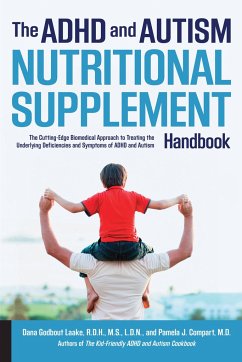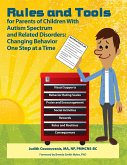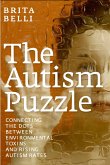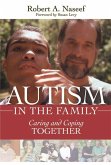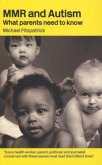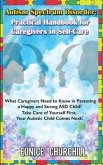Dana Laake, Pamela J Compart
ADHD and Autism Nutritional Supplement Handbook
The Cutting-Edge Biomedical Approach to Treating the Underlying Deficiencies and Symptoms of ADHD and Autism
Schade – dieser Artikel ist leider ausverkauft. Sobald wir wissen, ob und wann der Artikel wieder verfügbar ist, informieren wir Sie an dieser Stelle.
Dana Laake, Pamela J Compart
ADHD and Autism Nutritional Supplement Handbook
The Cutting-Edge Biomedical Approach to Treating the Underlying Deficiencies and Symptoms of ADHD and Autism
- Broschiertes Buch
- Merkliste
- Auf die Merkliste
- Bewerten Bewerten
- Teilen
- Produkt teilen
- Produkterinnerung
- Produkterinnerung
Doctor-nurse team Pamela Compart, M.D. and Dana Laake, R.D.H., M.S., L.D.N. say how to properly and safely use supplements and diet to counter autism.
Andere Kunden interessierten sich auch für
![Rules and Tools for Parents of Children with Autism Spectrum and Related Disorders Rules and Tools for Parents of Children with Autism Spectrum and Related Disorders]() Judith CoucouvanisRules and Tools for Parents of Children with Autism Spectrum and Related Disorders26,99 €
Judith CoucouvanisRules and Tools for Parents of Children with Autism Spectrum and Related Disorders26,99 €![The Autism Puzzle The Autism Puzzle]() Brita BelliThe Autism Puzzle13,99 €
Brita BelliThe Autism Puzzle13,99 €![Peanut Peanut]() Rebecca MariePeanut27,99 €
Rebecca MariePeanut27,99 €![Autism in the Family Autism in the Family]() Robert NaseefAutism in the Family29,99 €
Robert NaseefAutism in the Family29,99 €![MMR and Autism MMR and Autism]() Michael FitzpatrickMMR and Autism59,99 €
Michael FitzpatrickMMR and Autism59,99 €![Autism Spectrum Disorder Autism Spectrum Disorder]() Eunice ChurchillAutism Spectrum Disorder15,99 €
Eunice ChurchillAutism Spectrum Disorder15,99 €![Smart but Scattered Teens Unlocking Potential and Overcoming ADHD Challenges Smart but Scattered Teens Unlocking Potential and Overcoming ADHD Challenges]() Katherine SantosSmart but Scattered Teens Unlocking Potential and Overcoming ADHD Challenges16,99 €
Katherine SantosSmart but Scattered Teens Unlocking Potential and Overcoming ADHD Challenges16,99 €-
Doctor-nurse team Pamela Compart, M.D. and Dana Laake, R.D.H., M.S., L.D.N. say how to properly and safely use supplements and diet to counter autism.
Produktdetails
- Produktdetails
- Verlag: Fair Winds Press (MA)
- Seitenzahl: 256
- Erscheinungstermin: 1. März 2016
- Englisch
- Abmessung: 229mm x 152mm x 15mm
- Gewicht: 363g
- ISBN-13: 9781592337569
- ISBN-10: 1592337562
- Artikelnr.: 44604897
- Herstellerkennzeichnung
- Libri GmbH
- Europaallee 1
- 36244 Bad Hersfeld
- gpsr@libri.de
- Verlag: Fair Winds Press (MA)
- Seitenzahl: 256
- Erscheinungstermin: 1. März 2016
- Englisch
- Abmessung: 229mm x 152mm x 15mm
- Gewicht: 363g
- ISBN-13: 9781592337569
- ISBN-10: 1592337562
- Artikelnr.: 44604897
- Herstellerkennzeichnung
- Libri GmbH
- Europaallee 1
- 36244 Bad Hersfeld
- gpsr@libri.de
Dana Godbout Laake, RDH, MS, LDN, is a licensed nutritionist in Kensington, Maryland. Within her practice, Dana Laake Nutrition, she provides preventive and therapeutic medical nutrition therapy to adults and children. An honors graduate from Temple University (health sciences, dental hygiene), she received her master’s degree in nutrition from the University of Maryland. She was recipient of the Temple University 50th Anniversary Outstanding Alumnus award. Ms. Laake has served as a Maryland Legislative assistant on health issues, was coauthor of the legislation that established licensure boards for dietetics and nutrition in both Maryland and Washington, DC, and has served four gubernatorial appointments on two health care regulatory boards (dentistry and dietetics). She has been a partner in three functional medicine practices and provides local and national continuing education courses. In addition to writing and hosting a radio show, Dana is a scientific advisor and content contributor for the Autism Exchange and for the Neurological Health Foundation Healthy Child Guide. She is also coauthor of The ADHD and Autism Nutritional Supplement Handbook. Pamela J. Compart, MD, is a developmental pediatrician in Columbia, Maryland. She completed a pediatric residency at Children’s National Medical Center in Washington, DC, and fellowship training in Behavioral and Developmental Pediatrics at the University of Maryland School of Medicine. She combines traditional and complementary medicine approaches to the treatment of ADHD, autism, and other behavioral and developmental disorders. Dietary changes and use of nutritional supplements complement traditional treatments such as appropriate educational placement and speech therapy, occupational therapy, and other therapies. She founded and directed HeartLight Healing Arts, a multi-disciplinary integrated holistic health care practice providing services for children, adults, and families for 15 years. She is currently in solo practice, focusing on her passions of patient care, teaching, and writing. She is also coauthor of The ADHD and Autism Nutritional Supplement Handbook.
Foreword
Introduction
Chapter 1: The Journey Begins: Getting Started and Supplementing Safely
1.1 Nutrition 101: Terminology, Principles, Recommendations, and
Supplementation
A.Safety First: Do No Harm
B. No Speeding: How to Supplement—Start Low and Go Slow
C. Natural, Synthetic, and Artificial Nutrient Forms
D.Elemental Nutrients versus Nutrient Compounds
E. Nutrient Absorption Rates Vary to Maintain Homeostasis and Prevent
Toxicity
F. DRI/RDA Recommendations versus Individualized Recommendations
G.Supplement Description, Regulation, and Safety
H.Tips on Getting Your Child to Take Supplements
1.2 The Quick Start: Six Supplements with the Biggest Benefits and Fewest
Side Effects
A.Magnesium
B. Vitamin D
C. Zinc
D.Essential Omega-3 Fatty Acids
E. Probiotics
F. Multiple Vitamin Mineral
1.3 Fuel Stop: The Quick Start Diet—A Healthy Organic Diet
Chapter 2: Moving Forward: Supplementation Based on Specific Signs and
Symptoms
2.1 Allergies
2.2 Anger, Aggression, and Self-Injurious Behavior
2.3 Anxiety, Perseverations, Obsessive-Compulsive Symptoms, and Repetitive
Behaviors
2.4 Attention and Focus Problems
2.5 Communication and Language Delays
2.6 Constipation
2.7 Diarrhea
2.8 Eye Contact and Vision Problems
2.9 Fatigue, Poor Endurance, and Low Muscle Tone
2.10 Hyperactivity
2.11 Mood Issues
2.12 Pica
2.13 Picky Eating
2.14 Sensory Sensitivities
2.15 Silly Behavior and Inappropriate Giggling/Laughing
2.16 Skin Problems: Eczema, Dry Skin, and Rashes
2.17 Sleep Difficulties
2.18 Yeast Overgrowth
Chapter 3: Getting to Know the Landscape
3.1 Negotiating through the Territory: The Four Primary Systems
A. Gastrointestinal
B. Energy Metabolism and Mitochondria
C. Immune
D. Neurologic
3.2 Barriers and Bottlenecks: The Four Primary Mechanisms
A. Methylation
B. Sulfation
C. Oxidation
D. Inflammation
3.3 Stop Signs and Green Lights: How Environment Affects Genes
Chapter 4: Tuning the Engine: Nutrients and Their Impact on Impaired
Systems and Out-of-Sync Mechanisms
Vitamins
4.1 Vitamin A and Beta-carotene
4.2 Vitamin D
4.3 Vitamin E
4.4 The Busy Bs: B1, B2, B3
4.5 The Worker Bs: Methylation Nutrients: Vitamin B6, Methyl B12, Folate,
and DMG/TMG
4.6 The Helper B: Biotin
4.7 Vitamin C
Minerals
4.8 Magnesium and Calcium
4.9 Zinc
4.10 Selenium
Amino Acids
4.11 GABA and Theanine
4.12 Taurine
Other Nutrients and Cofactors
4.13 Carnitine
4.14 Coenzyme Q10
4.15 Essential Omega-3 Fatty Acids
4.16 Probiotics
4.17 Digestive Enzymes
Chapter 5: Avoiding Traffic Accidents and Traffic Jams: Toxic Metals and
Nutrient/Medication/Herb Interactions
5.1 Toxic Metals
5.2 Medication/Nutrient/Herb Interactions
Chapter 6: The Right Fuel: An Overview of Special Diets
6.1 Gluten-, Casein-, and Soy-Free (GFCFSF) Diet
6.2 Low Phenol/Salicylate (Feingold) Diet
6.3 Specific Carbohydrate Diet (SCD) and Gut and Psychology Syndrome (GAPS)
Diet
6.4 Anti-Yeast/Anti-Candida Diet and the Body Ecology Diet (BED)
6.5 Low Oxalate Diet (LOD)
6.6 FODMAP Diet
6.7 Rotation Diet
Chapter 7: Planning Ahead: The Preconception through Postnatal Action Plan
References
Acknowledgments
About the Authors
Index
Introduction
Chapter 1: The Journey Begins: Getting Started and Supplementing Safely
1.1 Nutrition 101: Terminology, Principles, Recommendations, and
Supplementation
A.Safety First: Do No Harm
B. No Speeding: How to Supplement—Start Low and Go Slow
C. Natural, Synthetic, and Artificial Nutrient Forms
D.Elemental Nutrients versus Nutrient Compounds
E. Nutrient Absorption Rates Vary to Maintain Homeostasis and Prevent
Toxicity
F. DRI/RDA Recommendations versus Individualized Recommendations
G.Supplement Description, Regulation, and Safety
H.Tips on Getting Your Child to Take Supplements
1.2 The Quick Start: Six Supplements with the Biggest Benefits and Fewest
Side Effects
A.Magnesium
B. Vitamin D
C. Zinc
D.Essential Omega-3 Fatty Acids
E. Probiotics
F. Multiple Vitamin Mineral
1.3 Fuel Stop: The Quick Start Diet—A Healthy Organic Diet
Chapter 2: Moving Forward: Supplementation Based on Specific Signs and
Symptoms
2.1 Allergies
2.2 Anger, Aggression, and Self-Injurious Behavior
2.3 Anxiety, Perseverations, Obsessive-Compulsive Symptoms, and Repetitive
Behaviors
2.4 Attention and Focus Problems
2.5 Communication and Language Delays
2.6 Constipation
2.7 Diarrhea
2.8 Eye Contact and Vision Problems
2.9 Fatigue, Poor Endurance, and Low Muscle Tone
2.10 Hyperactivity
2.11 Mood Issues
2.12 Pica
2.13 Picky Eating
2.14 Sensory Sensitivities
2.15 Silly Behavior and Inappropriate Giggling/Laughing
2.16 Skin Problems: Eczema, Dry Skin, and Rashes
2.17 Sleep Difficulties
2.18 Yeast Overgrowth
Chapter 3: Getting to Know the Landscape
3.1 Negotiating through the Territory: The Four Primary Systems
A. Gastrointestinal
B. Energy Metabolism and Mitochondria
C. Immune
D. Neurologic
3.2 Barriers and Bottlenecks: The Four Primary Mechanisms
A. Methylation
B. Sulfation
C. Oxidation
D. Inflammation
3.3 Stop Signs and Green Lights: How Environment Affects Genes
Chapter 4: Tuning the Engine: Nutrients and Their Impact on Impaired
Systems and Out-of-Sync Mechanisms
Vitamins
4.1 Vitamin A and Beta-carotene
4.2 Vitamin D
4.3 Vitamin E
4.4 The Busy Bs: B1, B2, B3
4.5 The Worker Bs: Methylation Nutrients: Vitamin B6, Methyl B12, Folate,
and DMG/TMG
4.6 The Helper B: Biotin
4.7 Vitamin C
Minerals
4.8 Magnesium and Calcium
4.9 Zinc
4.10 Selenium
Amino Acids
4.11 GABA and Theanine
4.12 Taurine
Other Nutrients and Cofactors
4.13 Carnitine
4.14 Coenzyme Q10
4.15 Essential Omega-3 Fatty Acids
4.16 Probiotics
4.17 Digestive Enzymes
Chapter 5: Avoiding Traffic Accidents and Traffic Jams: Toxic Metals and
Nutrient/Medication/Herb Interactions
5.1 Toxic Metals
5.2 Medication/Nutrient/Herb Interactions
Chapter 6: The Right Fuel: An Overview of Special Diets
6.1 Gluten-, Casein-, and Soy-Free (GFCFSF) Diet
6.2 Low Phenol/Salicylate (Feingold) Diet
6.3 Specific Carbohydrate Diet (SCD) and Gut and Psychology Syndrome (GAPS)
Diet
6.4 Anti-Yeast/Anti-Candida Diet and the Body Ecology Diet (BED)
6.5 Low Oxalate Diet (LOD)
6.6 FODMAP Diet
6.7 Rotation Diet
Chapter 7: Planning Ahead: The Preconception through Postnatal Action Plan
References
Acknowledgments
About the Authors
Index
Foreword
Introduction
Chapter 1: The Journey Begins: Getting Started and Supplementing Safely
1.1 Nutrition 101: Terminology, Principles, Recommendations, and
Supplementation
A.Safety First: Do No Harm
B. No Speeding: How to Supplement—Start Low and Go Slow
C. Natural, Synthetic, and Artificial Nutrient Forms
D.Elemental Nutrients versus Nutrient Compounds
E. Nutrient Absorption Rates Vary to Maintain Homeostasis and Prevent
Toxicity
F. DRI/RDA Recommendations versus Individualized Recommendations
G.Supplement Description, Regulation, and Safety
H.Tips on Getting Your Child to Take Supplements
1.2 The Quick Start: Six Supplements with the Biggest Benefits and Fewest
Side Effects
A.Magnesium
B. Vitamin D
C. Zinc
D.Essential Omega-3 Fatty Acids
E. Probiotics
F. Multiple Vitamin Mineral
1.3 Fuel Stop: The Quick Start Diet—A Healthy Organic Diet
Chapter 2: Moving Forward: Supplementation Based on Specific Signs and
Symptoms
2.1 Allergies
2.2 Anger, Aggression, and Self-Injurious Behavior
2.3 Anxiety, Perseverations, Obsessive-Compulsive Symptoms, and Repetitive
Behaviors
2.4 Attention and Focus Problems
2.5 Communication and Language Delays
2.6 Constipation
2.7 Diarrhea
2.8 Eye Contact and Vision Problems
2.9 Fatigue, Poor Endurance, and Low Muscle Tone
2.10 Hyperactivity
2.11 Mood Issues
2.12 Pica
2.13 Picky Eating
2.14 Sensory Sensitivities
2.15 Silly Behavior and Inappropriate Giggling/Laughing
2.16 Skin Problems: Eczema, Dry Skin, and Rashes
2.17 Sleep Difficulties
2.18 Yeast Overgrowth
Chapter 3: Getting to Know the Landscape
3.1 Negotiating through the Territory: The Four Primary Systems
A. Gastrointestinal
B. Energy Metabolism and Mitochondria
C. Immune
D. Neurologic
3.2 Barriers and Bottlenecks: The Four Primary Mechanisms
A. Methylation
B. Sulfation
C. Oxidation
D. Inflammation
3.3 Stop Signs and Green Lights: How Environment Affects Genes
Chapter 4: Tuning the Engine: Nutrients and Their Impact on Impaired
Systems and Out-of-Sync Mechanisms
Vitamins
4.1 Vitamin A and Beta-carotene
4.2 Vitamin D
4.3 Vitamin E
4.4 The Busy Bs: B1, B2, B3
4.5 The Worker Bs: Methylation Nutrients: Vitamin B6, Methyl B12, Folate,
and DMG/TMG
4.6 The Helper B: Biotin
4.7 Vitamin C
Minerals
4.8 Magnesium and Calcium
4.9 Zinc
4.10 Selenium
Amino Acids
4.11 GABA and Theanine
4.12 Taurine
Other Nutrients and Cofactors
4.13 Carnitine
4.14 Coenzyme Q10
4.15 Essential Omega-3 Fatty Acids
4.16 Probiotics
4.17 Digestive Enzymes
Chapter 5: Avoiding Traffic Accidents and Traffic Jams: Toxic Metals and
Nutrient/Medication/Herb Interactions
5.1 Toxic Metals
5.2 Medication/Nutrient/Herb Interactions
Chapter 6: The Right Fuel: An Overview of Special Diets
6.1 Gluten-, Casein-, and Soy-Free (GFCFSF) Diet
6.2 Low Phenol/Salicylate (Feingold) Diet
6.3 Specific Carbohydrate Diet (SCD) and Gut and Psychology Syndrome (GAPS)
Diet
6.4 Anti-Yeast/Anti-Candida Diet and the Body Ecology Diet (BED)
6.5 Low Oxalate Diet (LOD)
6.6 FODMAP Diet
6.7 Rotation Diet
Chapter 7: Planning Ahead: The Preconception through Postnatal Action Plan
References
Acknowledgments
About the Authors
Index
Introduction
Chapter 1: The Journey Begins: Getting Started and Supplementing Safely
1.1 Nutrition 101: Terminology, Principles, Recommendations, and
Supplementation
A.Safety First: Do No Harm
B. No Speeding: How to Supplement—Start Low and Go Slow
C. Natural, Synthetic, and Artificial Nutrient Forms
D.Elemental Nutrients versus Nutrient Compounds
E. Nutrient Absorption Rates Vary to Maintain Homeostasis and Prevent
Toxicity
F. DRI/RDA Recommendations versus Individualized Recommendations
G.Supplement Description, Regulation, and Safety
H.Tips on Getting Your Child to Take Supplements
1.2 The Quick Start: Six Supplements with the Biggest Benefits and Fewest
Side Effects
A.Magnesium
B. Vitamin D
C. Zinc
D.Essential Omega-3 Fatty Acids
E. Probiotics
F. Multiple Vitamin Mineral
1.3 Fuel Stop: The Quick Start Diet—A Healthy Organic Diet
Chapter 2: Moving Forward: Supplementation Based on Specific Signs and
Symptoms
2.1 Allergies
2.2 Anger, Aggression, and Self-Injurious Behavior
2.3 Anxiety, Perseverations, Obsessive-Compulsive Symptoms, and Repetitive
Behaviors
2.4 Attention and Focus Problems
2.5 Communication and Language Delays
2.6 Constipation
2.7 Diarrhea
2.8 Eye Contact and Vision Problems
2.9 Fatigue, Poor Endurance, and Low Muscle Tone
2.10 Hyperactivity
2.11 Mood Issues
2.12 Pica
2.13 Picky Eating
2.14 Sensory Sensitivities
2.15 Silly Behavior and Inappropriate Giggling/Laughing
2.16 Skin Problems: Eczema, Dry Skin, and Rashes
2.17 Sleep Difficulties
2.18 Yeast Overgrowth
Chapter 3: Getting to Know the Landscape
3.1 Negotiating through the Territory: The Four Primary Systems
A. Gastrointestinal
B. Energy Metabolism and Mitochondria
C. Immune
D. Neurologic
3.2 Barriers and Bottlenecks: The Four Primary Mechanisms
A. Methylation
B. Sulfation
C. Oxidation
D. Inflammation
3.3 Stop Signs and Green Lights: How Environment Affects Genes
Chapter 4: Tuning the Engine: Nutrients and Their Impact on Impaired
Systems and Out-of-Sync Mechanisms
Vitamins
4.1 Vitamin A and Beta-carotene
4.2 Vitamin D
4.3 Vitamin E
4.4 The Busy Bs: B1, B2, B3
4.5 The Worker Bs: Methylation Nutrients: Vitamin B6, Methyl B12, Folate,
and DMG/TMG
4.6 The Helper B: Biotin
4.7 Vitamin C
Minerals
4.8 Magnesium and Calcium
4.9 Zinc
4.10 Selenium
Amino Acids
4.11 GABA and Theanine
4.12 Taurine
Other Nutrients and Cofactors
4.13 Carnitine
4.14 Coenzyme Q10
4.15 Essential Omega-3 Fatty Acids
4.16 Probiotics
4.17 Digestive Enzymes
Chapter 5: Avoiding Traffic Accidents and Traffic Jams: Toxic Metals and
Nutrient/Medication/Herb Interactions
5.1 Toxic Metals
5.2 Medication/Nutrient/Herb Interactions
Chapter 6: The Right Fuel: An Overview of Special Diets
6.1 Gluten-, Casein-, and Soy-Free (GFCFSF) Diet
6.2 Low Phenol/Salicylate (Feingold) Diet
6.3 Specific Carbohydrate Diet (SCD) and Gut and Psychology Syndrome (GAPS)
Diet
6.4 Anti-Yeast/Anti-Candida Diet and the Body Ecology Diet (BED)
6.5 Low Oxalate Diet (LOD)
6.6 FODMAP Diet
6.7 Rotation Diet
Chapter 7: Planning Ahead: The Preconception through Postnatal Action Plan
References
Acknowledgments
About the Authors
Index

